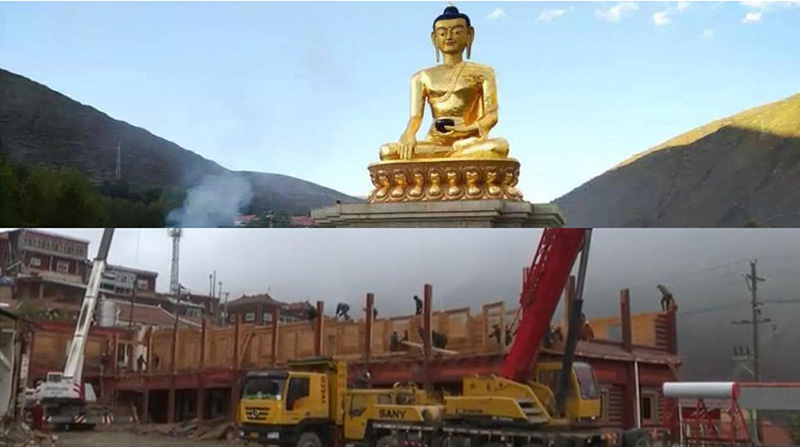Dharamshala, India — The 99-foot-tall Buddha statue and 45 prayer wheels were destroyed by local Chinese authorities in Draggo county, Kham, Tibet. Even though local Tibetans have legal documents for the construction of the giant Buddha statue, Chinese authorities demolished it six years after it was built.
According to a reliable source, Chinese authorities in Draggo county, Kham, Tibet, destroyed the 99-foot-tall Buddha statue, and 45 prayer wheels around a monastery. The destruction began on December 12, 2021, and the statues have now been completely demolished.
The construction of the Buddha statue was completed on October 5, 2015, at a cost of 4 million RMB with the financial support of local Tibetans in Draggo County, Kham, Tibet. It was established to prevent famine, war, and catastrophes of fire, water, earth, and air.
The source also said that in November 2021, these Chinese authorities destroyed the Gaden Namgyal Monastic School of Draggo monastery. This school had more than one hundred students and fifty rooms. This school taught Tibetan, Buddhist, English, and Chinese.
"Before the Chinese authorities destroyed the Buddha statue in the Draggo county, the authorities summoned the senior monks of Draggo Monastery to the local Chinese police station in Draggo, detained them and warned them for 15 days." They warned, "If the monks do not let the Chinese authorities destroy the statue, they will destroy them and take everything to the Chinese city," said Palden, citing sources in Draggo county.
"After that, the Chinese authorities summoned the khenpo (abbot) and treasurer of the Draggo monastery to the Chinese police station and ordered them to gather all monks to destroy the Buddha statue. The Chinese authorities warned that if anyone did not come to destroy the statue, they would be inspected individually and could be arrested or get heavy punishment,” he added.
"The monks who showed unwillingness to destroy the statue or did not cooperate with the Chinese authorities were summoned to the police station and were severely interrogated and punished,” the source said.
Palden also mentioned that a Tibetan from Draggo County said with tears in his eyes that the Chinese authorities also burned, buried, and threw Tibetan prayer flags(Mani flag) and Mani stones into the water, just like the second cultural revolution taking place in Tibet.
Over the past 70 decades, there has been ongoing political repression, social discrimination, economic marginalization, environmental destruction, and cultural assimilation, particularly due to Chinese migration to Tibet which is fueling intense resentment among the people of occupied Tibet.
The communist-totalitarian state of China began its invasion of Tibet in 1949, reaching complete occupation of the country in 1959. Since that time, more than 1.2 million people, 20% of the nation's population of six million, have died as a direct result of China's invasion and occupation. In addition, over 99% of Tibet's six thousand religious monasteries, temples, and shrines, have been looted or decimated resulting in the destruction of hundreds of thousands of sacred Buddhist scriptures.
Until 1949, Tibet was an independent nation in the Himalayas which had little contact with the rest of the world. It existed as a rich cultural storehouse — a unifying theme among the Tibetans — as was their own language, literature, art, and world view developed by living at high altitudes, under harsh conditions, in a balance with their environment.


![Tibet has a rich history as a sovereign nation until the 1950s when it was invaded by China. [Photo: File]](/images/stories/Pics-2024/March/Tibet-Nation-1940s.jpg#joomlaImage://local-images/stories/Pics-2024/March/Tibet-Nation-1940s.jpg?width=1489&height=878)


















